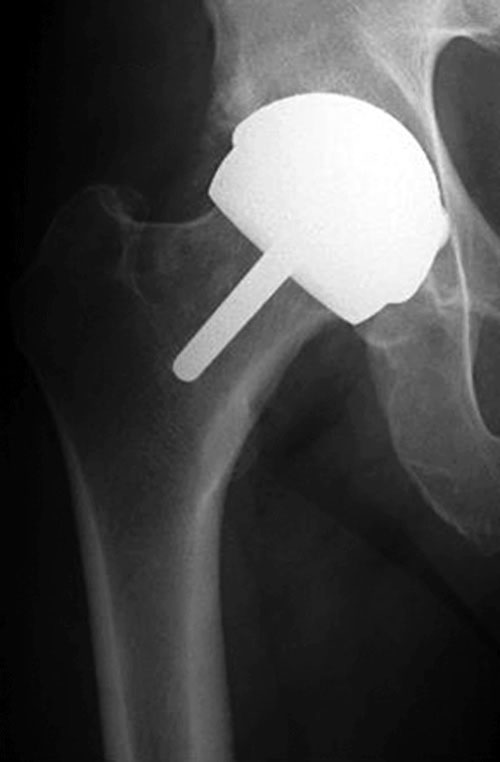
700 Glenhuntly Road
Caulfield VIC 3162
03 9044 4555

700 Glenhuntly Road
Caulfield VIC 3162
03 9044 4555
Hip Resurfacing

EXAMPLE ONLY
One variation on the concept of total hip replacement (THR) is hip resurfacing. While this operation was originally performed two decades prior to the popularisation of the conventional total hip replacement it fell out of favour, as THR seemed to have a more predictable outcome. In the late 1990’s hip resurfacing was “reborn” due to a perceived need to give younger, more active patients with end-stage osteoarthritis an operation to remove the arthritic surfaces and pain, while attempting to spare as much bone as possible, maintain or improve stability compared to conventional total hip replacement, and allow for easy revision when it did fail, into a THR. This was facilitated by innovations in the degree of accuracy seen in computerised manufacture of hip components, better understanding of the metallurgy required to reduce the rate of wear of the moving parts, and improved technical skill of surgeons in performing complex surgery.
Both hip resurfacing and total hip replacement are performed for end-stage hip arthritis and require the removal of diseased acetabular cartilage and bone and implantation of an acetabular shell. In a resurfacing, the acetabular shell is made of cobalt-chrome alloy (that has been used safely in orthopaedic surgery for nearly 40 years) and does not have a separate liner that needs to be implanted into the shell – the inner metal surface of the shell is extremely smooth and is the actual bearing surface. The gap (or tolerance) between the moving surfaces in a hip resurfacing has also been determined by detailed computer analysis to give the best combination of lubrication and minimal contact between surfaces, thus prolonging wear.
In a total hip replacement the entire femoral head and femoral neck are cut off and removed from the upper femur and a canal is bored into the bone marrow of the thigh-bone to allow implantation of the femoral stem. The difference in a hip resurfacing, is that only the worn out cartilage surface and a small amount of underlying bone on the surface of the femoral head is removed, essentially leaving a “core” of the majority of the femoral head bone stock as well as all of the femoral neck intact. Then a metal cap is applied on top of the remaining core of bone, covering it over with a sphere of cobalt-chrome alloy – the resurfacing. The resurfaced femoral head is then put back into the acetabular shell.
As with all type of THR, there are a few advantages (as well as disadvantages) with hip resurfacing. The main advantage is that the femoral head is considerably larger in a resurfacing than would be used in a conventional total hip replacement – frequently measuring above 50mm in diameter in the resurfacing, compared to 32mm or 36mm in the total hip replacement. The advantage of this is that the larger femoral head will result in a much more stable joint, reducing the chance of dislocation and increasing the safe range of movement and range of flexibility in a resurfacing compared to a total hip replacement. Another practical advantage is that if it came time to revise a resurfacing, there is more bone stock available on the femoral side, as the femoral neck has been preserved in the resurfacing. This would permit for a conversion into a traditional total hip replacement, with the ability of still being able to use a larger head.
While this sounds to be a very attractive surgical option, since approximately 2009 there have been some discoveries that show possible weaknesses with this type of surgery in some patients, and, like THR, resurfacing may not be the best option in every patient. In particular, female patients with small bones, elderly patients with weaker bone quality or patients with smaller natural femoral head sizes have been found to have more frequent or earlier than anticipated problems with hip resurfacing, more so than would be expected if they had had a conventional total hip replacement. Not all the reasons for this have been clearly identified; these are merely “risk factors” for earlier than anticipated revision of a resurfacing to a total hip replacement. However, young, male patients (especially those under the age of approximately 55) who undergo hip resurfacing with one or two specific brands of implant have been shown to have a substantially better performance as far as survival of the implant is concerned. In fact, in this setting, these resurfacing implants are performing better in these patients than would be expected if they had had a total hip replacement instead. Again, the reasons for this are not immediately clear and are the focus of ongoing research within the orthopaedic community.
It is extremely important to note that not all brands of resurfacing are the same, with some doing extremely poorly and having a much higher rate of revision surgery, while a few have done exceptionally well overall with very low revision rates. Unfortunately, for this reason, their overall popularity with orthopaedic surgeons has fallen over the past few years. Your suitability for hip resurfacing is best discussed on an individual basis with your own surgeon.
Both hip resurfacing and total hip replacement are performed for end-stage hip arthritis and require the removal of diseased acetabular cartilage and bone and implantation of an acetabular shell. In a resurfacing, the acetabular shell is made of cobalt-chrome alloy (that has been used safely in orthopaedic surgery for nearly 40 years) and does not have a separate liner that needs to be implanted into the shell – the inner metal surface of the shell is extremely smooth and is the actual bearing surface. The gap (or tolerance) between the moving surfaces in a hip resurfacing has also been determined by detailed computer analysis to give the best combination of lubrication and minimal contact between surfaces, thus prolonging wear.
In a total hip replacement the entire femoral head and femoral neck are cut off and removed from the upper femur and a canal is bored into the bone marrow of the thigh-bone to allow implantation of the femoral stem. The difference in a hip resurfacing, is that only the worn out cartilage surface and a small amount of underlying bone on the surface of the femoral head is removed, essentially leaving a “core” of the majority of the femoral head bone stock as well as all of the femoral neck intact. Then a metal cap is applied on top of the remaining core of bone, covering it over with a sphere of cobalt-chrome alloy – the resurfacing. The resurfaced femoral head is then put back into the acetabular shell.
As with all type of THR, there are a few advantages (as well as disadvantages) with hip resurfacing. The main advantage is that the femoral head is considerably larger in a resurfacing than would be used in a conventional total hip replacement – frequently measuring above 50mm in diameter in the resurfacing, compared to 32mm or 36mm in the total hip replacement. The advantage of this is that the larger femoral head will result in a much more stable joint, reducing the chance of dislocation and increasing the safe range of movement and range of flexibility in a resurfacing compared to a total hip replacement. Another practical advantage is that if it came time to revise a resurfacing, there is more bone stock available on the femoral side, as the femoral neck has been preserved in the resurfacing. This would permit for a conversion into a traditional total hip replacement, with the ability of still being able to use a larger head.
While this sounds to be a very attractive surgical option, since approximately 2009 there have been some discoveries that show possible weaknesses with this type of surgery in some patients, and, like THR, resurfacing may not be the best option in every patient. In particular, female patients with small bones, elderly patients with weaker bone quality or patients with smaller natural femoral head sizes have been found to have more frequent or earlier than anticipated problems with hip resurfacing, more so than would be expected if they had had a conventional total hip replacement. Not all the reasons for this have been clearly identified; these are merely “risk factors” for earlier than anticipated revision of a resurfacing to a total hip replacement. However, young, male patients (especially those under the age of approximately 55) who undergo hip resurfacing with one or two specific brands of implant have been shown to have a substantially better performance as far as survival of the implant is concerned. In fact, in this setting, these resurfacing implants are performing better in these patients than would be expected if they had had a total hip replacement instead. Again, the reasons for this are not immediately clear and are the focus of ongoing research within the orthopaedic community.
It is extremely important to note that not all brands of resurfacing are the same, with some doing extremely poorly and having a much higher rate of revision surgery, while a few have done exceptionally well overall with very low revision rates. Unfortunately, for this reason, their overall popularity with orthopaedic surgeons has fallen over the past few years. Your suitability for hip resurfacing is best discussed on an individual basis with your own surgeon.
The information above is general. All surgical procedures involve some risk. If you would like advice on your specific condition, please contact Oasis Orthopaedics to make an appointment with one of our specialists.
